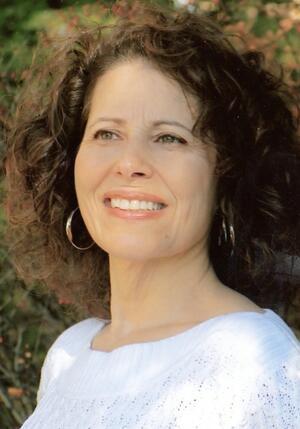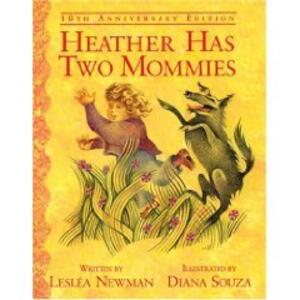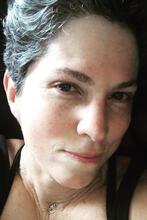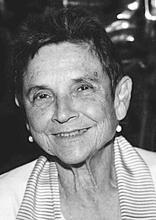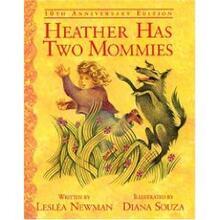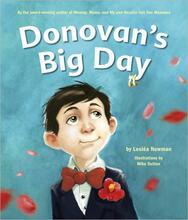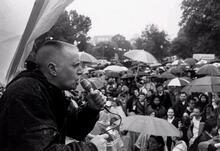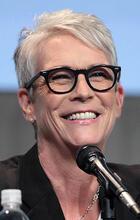Lesléa Newman
Lesbian feminist writer Lesléa Newman made history in 1989 with her controversial children’s book, Heather Has Two Mommies, the first children’s book with LGBTQ characters to garner broad attention. The book was inspired by Newman’s friend, a lesbian mother who complained that there were no children’s books with families that looked like hers, but also by Newman’s own childhood experience of not seeing herself represented as a Jew. The book sparked national controversy, but it quickly became beloved by countless children in LGBTQ families. Newman has also written many books for children, adolescents, and adults on homosexuality, Jewish identity, eating disorders, and AIDS. Themes of courage and resilience appear throughout her work.
Introduction
“The most important thing about a family is that all the people in it love each other.”
These words, from Lesléa Newman’s Heather Has Two Mommies, have been bedtime staples for countless children in LGBTQ families, who have benefited from seeing themselves depicted in Newman’s now classic book. Published in 1989 as the first children’s book with LGBTQ characters to garner broad attention, the book has played a groundbreaking role in American society. It is also just one of 75 books for readers of all ages that Lesléa Newman has written, including A Letter to Harvey Milk; October Mourning: A Song for Matthew Shepard; I Carry My Mother; The Boy Who Cried Fabulous; Ketzel, the Cat Who Composed; and Gittel’s Journey: An Ellis Island Story.
Early Life
Lesléa Newman was born in Brooklyn in 1955. Her father, Edward, was an attorney and CPA; her mother, Florence, was a homemaker. Newman started writing as a child after her family moved from Brooklyn to Long Island. She later recalled, “I missed my school, my neighborhood, my grandmother who had lived across the street from us and was now a 40-minute drive away. I started writing very sad poetry, about dogs getting run over, and things like that. I think it’s very interesting that as an 8-year-old I knew had to find a way to express my sadness, and without anyone’s encouragement or prodding, I chose poetry to do so” (Mass Poetry).
Launching a Career as a Writer
Newman began her writing career as a poet. Her first book was a chapbook called Just Looking for My Shoes (Back Door Press, 1981). After a few years of writing and working various jobs to support herself, she resolved to focus exclusively on writing. She has never looked back. She published her first novel, Good Enough to Eat, in 1986 and launched her own business, “Write from the Heart,” teaching writing workshops to women.
Newman’s Jewish identity has always informed her identity as a lesbian, as well as her commitment to social justice. She reflected, “Being raised as a Jew was great preparation for being a lesbian because I was surrounded by strong Jewish women, and I was taught early on that community and social justice were very important. I carry those values through my whole life as a Jew, and then also in the LGBTQ community.”
Likewise, Newman brought her Jewish identity to her marriage ceremony with Mary Grace Newman Vazquez in 1989—creating a “commitzvah” long before their marriage was recognized by any government.
Representation and Controversy: Heather Has Two Mommies
In a story that has become lore in the LGBTQ community, Newman recalls how she came to write her first children’s book, Heather Has Two Mommies (In Other Words Publishing, 1989): “[A] woman stopped me on the street in Northampton, where I was living at the time, and which is famous for its LGBTQ+ community. She said that she did not have a book to read to her daughter that showed a family like theirs—a family comprised of two moms and their child—and someone should write one. So I did, and the rest as they say is history” (Smith).
Newman knew what it felt like not to see yourself represented. In a 2012 blog post, she remembered:
I also knew firsthand what it felt like to not have my own family portrayed in a book, movie, or on TV, because I grew up in the 1950s and never read a book about a little girl with curly brown hair eating matzo ball soup with her bubbe on Friday night. I read books about children being visited by Santa Claus or the Easter Bunny, which were things my family did not do. So I felt different. Which is why I wrote Heather Has Two Mommies. (Newman, “5 Questions With”).
She recalled clearly the first time she saw a Jewish children’s book. “I was in a bookstore at about twenty-seven-years-old and it was The Carp in the Bathtub…. I pulled it off the shelf and looked at it. I saw a family just like mine, and in the bookstore, I began to cry.”
While many families and children embraced the book—especially lesbian mothers who were thrilled to see their families represented—others treated this children’s book as radical, shocking, and dangerous. Newman recalls, “The book very quickly became this cultural icon that stood for the destruction of civilization…. It was burned, banned, defecated on, challenged in libraries, returned to libraries with pages glued shut.”
By the end of the 1990s, Heather Has Two Mommies was the ninth most banned book of the decade, beating out J.D. Salinger’s The Catcher in the Rye and Madonna’s Sex. Yet parents, librarians, and educators never stopped reaching for this book, which was reissued with new illustrations and updated text by Candlewick Press on its 25th anniversary in 2015.
Writing “Books that Matter”
And Newman, too, has persisted, publishing dozens of books for children—board books, picture books, novels for tweens, and YA novels. She’s also written for adults—poetry, short story collections, novels, books of humor, and personal essays. No matter the genre, her priority has always been “to write books that matter” (Smith).
Indeed, Lesléa Newman’s books always hone in on critical, sometimes painful, truths. Her 2012 book, October Mourning: A Song for Matthew Shepard (Candlewick, 2012), offers a stunning collection of 68 poems to remember Shepard’s murder, honor his life, and reflect on his impact on the world. In the fall of 1998, Newman had arrived in Laramie, Wyoming, to give a keynote address at the University of Wyoming’s Gay Awareness Week just five days after Matthew Shepard was found tied to a fence, brutally beaten and left to die. She describes how she looked out at an empty seat in the front row, imagined Matthew sitting there, and vowed to dedicate every LGBTQ rights speech she would give for the rest of her life to his memory.
Written as a novel-in-verse, October Mourning tells the story of Shepard’s murder from multiple perspectives—his own, his killers’, that of the fence to which he was tied and a deer that kept him company throughout the long, cold night, and others. The winner of numerous young adult book awards, the collection illuminates this shattering tragedy for readers who are too young to remember it.
Newman often reads from October Mourning as part of her presentation, “He Continues to Make a Difference: The Story of Matthew Shepard.” She has shared how teens can feel inspired to make a difference after learning about Shepard’s murder: “So many teens have said things like, ‘I’m not going to use the word ‘fag’ anymore,’ or ‘The next time I hear someone say ‘That’s so gay’ I’m going to call them on it.’ It takes a lot of courage to stand up in front of your whole school and make a statement like that” (Lesléa Newman Turns Hate Into Love).
Windows and Mirrors
Themes of courage and resilience appear throughout Newman’s works. When she saw the expressions of fear and hope on the faces of Syrian refugees in a boat off the coast of Turkey, she immediately thought of her Aunt Phyllis' mother, Sadie, who came to this country on her own as a child. Sadie had a piece of paper with a relative’s address with her, but by the time the ship docked in New York, the ink had become illegibly smudged. Without a relative to call, Sadie was not permitted to leave Ellis Island. Only after her photo was posted in a local Jewish newspaper was she seen by a family member, who came to meet her and help her start her new life. These family memories and Newman’s awareness of the immigrant and refugee crisis of the twenty-first century inspired her to write Gittel’s Journey: An Ellis Island Story (Abrams, 2019) (Kaden).
Gittel’s Journey joins Newman’s other works in inspiring empathy and action by readers. When asked to describe her writing process, Newman explains that she keeps in mind the concept of “Windows and Mirrors,” which was defined by Rudine Sims Bishop, a scholar and expert in children’s literature (Schneider). The idea is that children need both mirrors (literature that reflects their own lives) and windows (literature that helps them see the rest of humanity).
In fact, adults also need both mirrors and windows in order to feel seen and to engage, understand, and discern how to make meaning of our lives. In Newman’s powerful short story, “A Letter to Harvey Milk” (Firebrand, 1988), Newman draws from her own experience as a young writer who taught writing workshops to seniors to bring the late Harvey Milk to life for the reader. All the facts she presents about Milk are true, from the mundane (his love of jelly beans) to the profound and tragic (his prediction of his own death). Newman was inspired by three books to craft this story: The Men with the Pink Triangle: The True Life-and-Death Story of Homosexuals in the Nazi Death Camps by Heinz Heger; Number Our Days: A Triumph of Continuity and Culture Among Jewish Old People in an Urban Ghetto by Barbara Myerhoff; and The Mayor of Castro Street: The Life and Times of Harvey Milk by Randy Shilts.
“A Letter to Harvey Milk” was adapted by Yariv Kohn into both an award-winning short film, called Harvey Weinberg’s Notebook, and a musical, which had a successful sixteen-week off-Broadway run. It is noteworthy that “A Letter to Harvey Milk” was the only short story with overtly Jewish content in the anthology Women on Women: An Anthology of American Lesbian Short Fiction, edited by Joan Nestle and Naomi Holoch, and the only short story with overtly lesbian content in the anthology America and I: Short Stories by American Jewish Women Writers, edited by Joyce Antler.
In ”A Letter to Harvey Milk,” a young woman named Rachel says, “Being a lesbian is lonely…Being a Jew is lonely…Being alive is lonely.” In naming that universal loneliness, Newman invites every reader into a moment of profound connection and recognition. What greater gift can literature provide?
“Getting to Know Lesléa Newman & Her New Book, I Wish My Father.” Mass Poetry, 2020; https://masspoetry.org/new-book-newman.
Kaden, Arielle. “Giving Voice to Jewish Characters in Children’s Literature – A Conversation with Lesléa Newman.” The Forward, July 9, 2019.
“Lesléa Newman Turns Hate Into Love.” Curve, September 6, 2020; https://www.curvemag.com/blog/lesla-newman-turns-hate-into-love/.
Newman, Lesléa. “5 Questions With… Lesléa Newman (October Mourning.” International Literacy Association, October 5, 2012; https://www.literacyworldwide.org/blog/literacy-now/2012/10/05/5-questions-with-lesl%C3%A9a-newman-(october-mourning).
Schneider, Emily. “Mirrors and Windows: A Conversation with Lesléa Newman on Diversity in Children’s Books.” Jewish Book Council, December 3, 2019; https://www.jewishbookcouncil.org/pb-daily/mirrors-and-windows-a-conversation-with-leslea-newman-on-diversity-in-childrens-books.
Smith, Cynthia Leitich. “Career Achievers: Lesléa Newman on Thriving as a Long-Time, Actively Publishing Children’s-YA Author.” Cynthia Leitich Smith, March 2019; https://cynthialeitichsmith.com/2019/03/survivors-leslea-newman-on-thriving-as-a-long-time-actively-publishing-childrens-ya-author/.
Stern, Mark Joseph. “Heather Has Two Mommies, and Morris Has a Dress.” Slate, August 3, 2016; https://slate.com/culture/2016/08/lgbtq-childrens-book-authors-leslea-newman-and-christine-baldacchino-interviewed.html.

